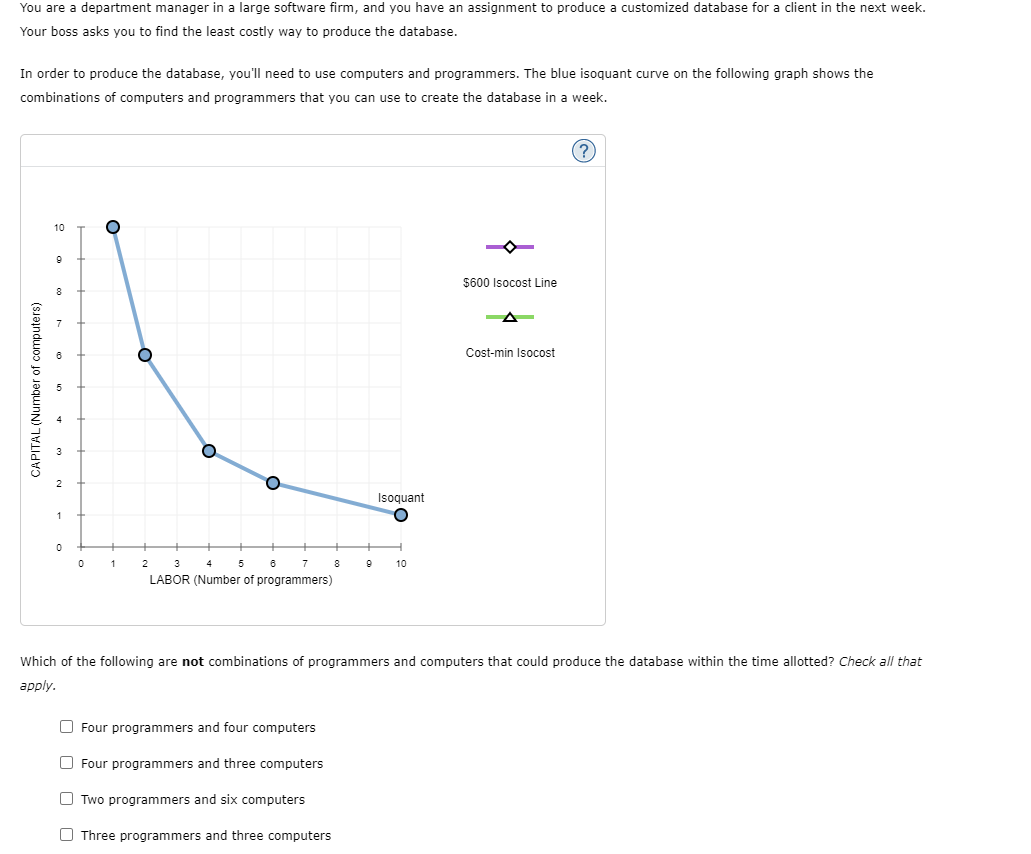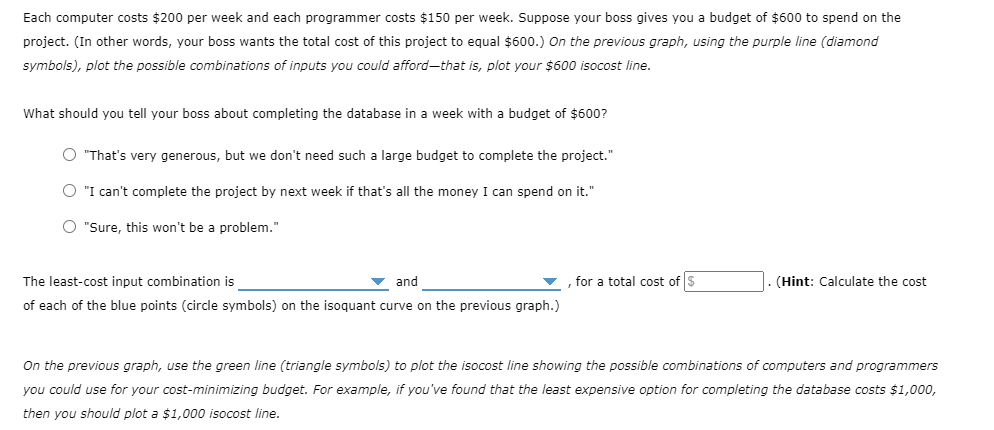You are a department manager in a large software firm, and you have an assignment to produce a customized database for a client in the next week. Your boss asks you to find the least costly way to produce the database. In order to produce the database, youll need to use computers and programmers. The blue isoquant curve on the following graph shows the combinations of computers and programmers that you can use to create the database in a week. 10 S600 Isocost Line Cost-min Isocost 2 Isoquant 1 2 3 4 5 6 7 8 9 1 10 LABOR (Number of programmers) Which of the following are not combinations of programmers and computers that could produce the database within the time allotted? Check all that аpply. Four programmers and four computers Four programmers and three computers Two programmers and six computers Three programmers and three computers CAPITAL (Number of computers) co
You are a department manager in a large software firm, and you have an assignment to produce a customized database for a client in the next week. Your boss asks you to find the least costly way to produce the database. In order to produce the database, youll need to use computers and programmers. The blue isoquant curve on the following graph shows the combinations of computers and programmers that you can use to create the database in a week. 10 S600 Isocost Line Cost-min Isocost 2 Isoquant 1 2 3 4 5 6 7 8 9 1 10 LABOR (Number of programmers) Which of the following are not combinations of programmers and computers that could produce the database within the time allotted? Check all that аpply. Four programmers and four computers Four programmers and three computers Two programmers and six computers Three programmers and three computers CAPITAL (Number of computers) co
Microeconomics: Principles & Policy
14th Edition
ISBN:9781337794992
Author:William J. Baumol, Alan S. Blinder, John L. Solow
Publisher:William J. Baumol, Alan S. Blinder, John L. Solow
Chapter7: Production, Inputs, And Cost: Building Blocks For Supply Analysis
Section: Chapter Questions
Problem 8TY
Related questions
Question
100%
You are a department manager in a large software firm, and you have an assignment to produce a customized database for a client in the next week. Your boss asks you to find the least costly way to produce the database.
In order to produce the database, you'll need to use computers and programmers. The blue isoquant curve on the following graph shows the combinations of computers and programmers that you can use to create the database in a week.

Transcribed Image Text:You are a department manager in a large software firm, and you have an assignment to produce a customized database for a client in the next week.
Your boss asks you to find the least costly way to produce the database.
In order to produce the database, you'll need to use computers and programmers. The blue isoquant curve on the following graph shows the
combinations of computers and programmers that you can use to create the database in a week.
10
$600 Isocost Line
8
Cost-min Isocost
Isoquant
2
3
4
6
8.
10
LABOR (Number of programmers)
Which of the following are not combinations of programmers and computers that could produce the database within the time allotted? Check all that
apply.
O Four programmers and four computers
O Four programmers and three computers
O Two programmers and six computers
O Three programmers and three computers
CAPITAL (Number of computers)

Transcribed Image Text:Each computer costs $200 per week and each programmer costs $150 per week. Suppose your boss gives you a budget of $600 to spend on the
project. (In other words, your boss wants the total cost of this project to equal $600.) On the previous graph, using the purple line (diamond
symbols), plot the possible combinations of inputs you could afford-that is, plot your $600 isocost line.
What should you tell your boss about completing the database in a week with a budget of $600?
O "That's very generous, but we don't need such a large budget to complete the project."
O "I can't complete the project by next week if that's all the money I can spend on it."
O "Sure, this won't be a problem."
The least-cost input combination is
and
for a total cost of s
(Hint: Calculate the cost
of each of the blue points (circle symbols) on the isoquant curve on the previous graph.)
On the previous graph, use the green line (triangle symbols) to plot the isocost line showing the possible combinations of computers and programmers
you could use for your cost-minimizing budget. For example, if you've found that the least expensive option for completing the database costs $1,000,
then you should plot a $1,000 isocost line.
Expert Solution
This question has been solved!
Explore an expertly crafted, step-by-step solution for a thorough understanding of key concepts.
This is a popular solution!
Trending now
This is a popular solution!
Step by step
Solved in 4 steps with 2 images

Knowledge Booster
Learn more about
Need a deep-dive on the concept behind this application? Look no further. Learn more about this topic, economics and related others by exploring similar questions and additional content below.Recommended textbooks for you

Microeconomics: Principles & Policy
Economics
ISBN:
9781337794992
Author:
William J. Baumol, Alan S. Blinder, John L. Solow
Publisher:
Cengage Learning


Microeconomics: Principles & Policy
Economics
ISBN:
9781337794992
Author:
William J. Baumol, Alan S. Blinder, John L. Solow
Publisher:
Cengage Learning
